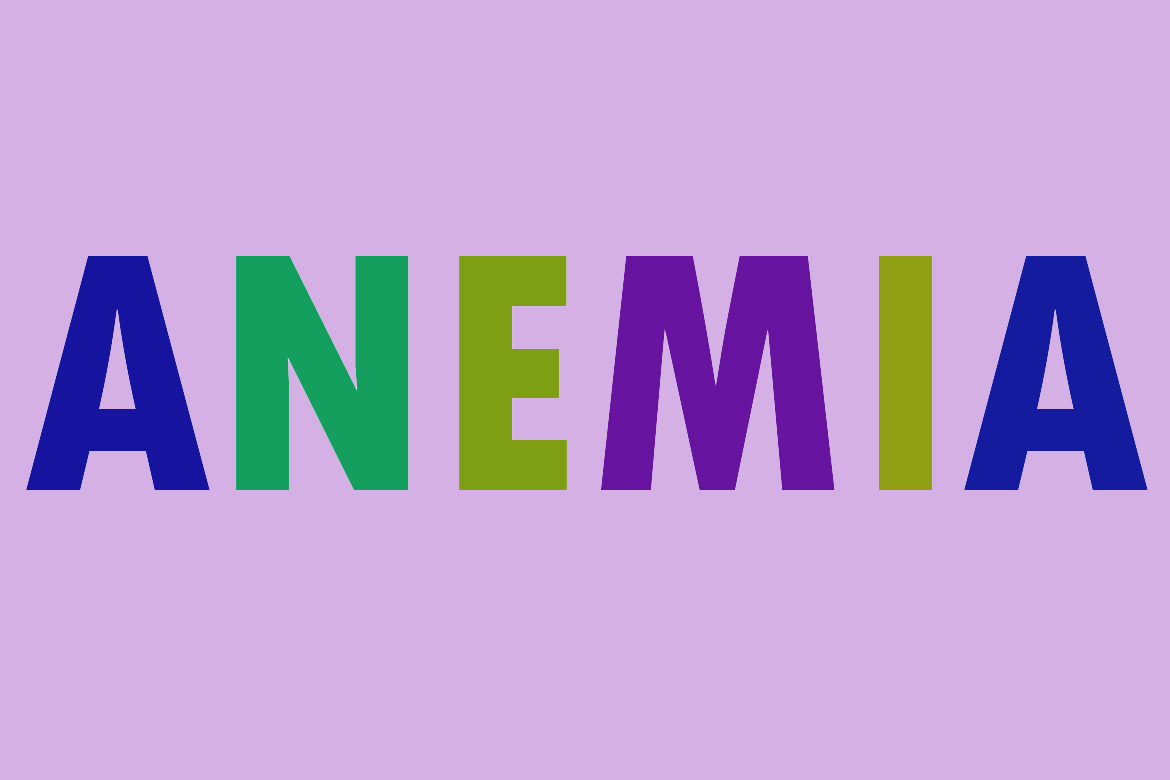
Anemia occurs when the number of red blood cells circulating in the body decreases. It is the most common blood disorder.
Causes of Anemia
There are three main reasons people become anemic: blood loss, a reduction in the body’s ability to produce new red blood cells, or an illness that leads to increased destruction of red blood cells.
Common Types of Anemia
1. Iron-deficiency anemia is the most common type of anemia. It happens when you do not have enough iron in your body. Iron deficiency is usually due to blood loss but may occasionally be due to poor absorption of iron.
Functions of Iron
Iron is critical for every cell. It’s many functions include:
• Oxygen transport – Iron is the central atom in hemoglobin, which carries oxygen in blood.
• Muscle function – Myoglobin, the main muscle protein , requires iron.
• Energy production – Iron is required in the cytochrome enzyme system in the electron transport section of the Krebs energy cycle. Cooper is also involved in this enzyme system.
• Detoxification and protection from free radicals – Iron is also needed for the superoxide, peroxidase, glutathione and catalase enzyme systems. Glutathione peroxidise is a primary enzyme in the liver detoxification pathways. The catalase , superoxide and peroxidise systems have to do with removing free radicals from the body to prevent oxidant damage.
• The brain – Iron is used in animals and probably humans for the sense of direction.
Tiny magnetic particles of iron or manganese guide animals and perhaps humans, acting like compasses that respond to the magnetic poles of the earth.
• Sexuality and emotions – Iron is a lower ‘male’ element and associated with anger and rage.
• Hormones – In animals, at least, iron is also involved in the synthesis of the catecholamines such as epinephrine, norepinephrine and dopamine.
2.Vitamin Deficiencies
Many vitamins play a role in blood formation. Anemia can result from a deficiency of vitamin B6, B12, folic acid, or vitamin C. Liver or kidney disease, due to nutritional imbalances, can also cause anemia. Malabsorption, caused by a gluten sensitivity or other factors, may cause anemia.
Conditions such as alcoholism often interfere with proper diet. This can contribute to an anemic condition. Strict vegetarian diets may be low in vitamin B12, causing a serious condition called pernicious anemia.
Chronic or acute infections can cause anemia. When an infection is present, the body will remove iron from the blood and replace it with copper. This is because iron favors the growth of bacteria. Copper has an anti-bacterial effect.
The solution is to correct the infection. The anemia will then subside. Giving supplemental iron when an infection is present may worsen the infection.
Signs and symptoms of Anemia may include:
• Extreme fatigue
• Weakness
• Pale skin
• Chest pain, fast heartbeat or shortness of breath
• Headache, dizziness or light headedness
• Insomnia
• Cold hands and feet
• Inflammation or soreness of your tongue
• Brittle nails
Anemia is a very common and important symptom. There are many types of anemia, often divided into:
1) Those caused by low or inadequate production of red blood cells, and
2) Those caused by too rapid destruction of red blood cells. Usually this occurs when the red blood cells are not healthy and robust.
Toxic metals. Most toxic metals can cause anemias. This is largely overlooked by doctors because there is no easy way to measure all the toxic metals, especially deep in the bone marrow where blood is made.
Copper anemia. A very common type of anemia that is not well understood by doctors is due to copper imbalance. It is usually mild, and on tests it looks exactly like iron deficiency anemia. Doctors give iron for it. However, taking iron does not correct it completely.
Hair analysis reveals that many people have biounavailable copper, or a copper deficiency. Either can disrupt normal blood formation.
Copper is needed to convert ferrous to ferric iron and to incorporate iron into hemoglobin. Copper deficiency anemia looks like iron deficiency anemia on a blood test and one may confuse the two.
It is much more common in women, and not because of blood loss due to menstruation. Women have more copper imbalance than men. To correct it, one must correct the copper imbalance. This requires a nutritional balancing program, in most cases.
Lead Anemia
Lead poisoning is a less common but important cause of anemia. Lead contributes to anemia in two ways. Lead inhibits the incorporation of iron into the heme molecule. It also inhibits an enzyme, 5-nucleotidase, needed to make blood. This causes a hemolytic anemia. Hair analysis is an excellent method to help identify chronic lead toxicity.
Some of the best plant sources of iron are:
• Beans and lentils
• Tofu
• Baked potatoes
• Pumpkin and sunflower seeds
• Nuts especially cashews and almonds
• Fortified breakfast cereals
• Whole-grain and enriched breads
• Dried apricots
• Vegetables such as kale, broccoli, spinach and green peas
References:
Nutritional Balancing and Hair Mineral Analysis by Dr. Lawrence Wilson



Faleminderit per kete informacion te rendesishem qe na keni ofruar ne lidhje me shkaqet e anemise, sidomos kur shkaku i anemise eshte c’ekuilibrimi i bakrit ne trupin tone,dicka qe une nuk e kisha degjuar me pare. Nepermjet ketij informacioni kuptova sesa i vlefshem eshte ky test floku i cili na tregon shkaqet e nje sere semundjesh ne trupat tane.
As nuk e kisha idene,njohurite e mia mbi anemine paskan qene shume te percipta.Te falenderoj shume per te gjithe informacionin e dobishem.Po e lexoj me shume vemendje e madje po e shperndaj